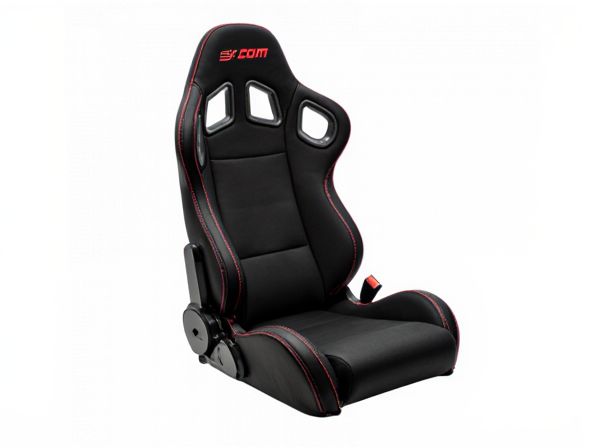
Photo illustration: Racing Seat vs Touring Seat
Racing seats are designed for maximum support and safety during high-speed driving, featuring deep bolsters and harness compatibility to keep you securely in place. Touring seats prioritize comfort for long-distance driving, offering adjustable cushioning and ergonomic design to reduce fatigue. Your choice depends on whether you need performance-oriented stability or everyday comfort for extended journeys.
Table of Comparison
| Feature | Racing Seat | Touring Seat |
|---|---|---|
| Purpose | Designed for high-performance driving and maximum support | Engineered for comfort during long-distance drives |
| Support | Enhanced lateral support with deep bolsters | Moderate support for relaxed seating posture |
| Material | Lightweight materials like carbon fiber or fiberglass | Durable, cushioned fabrics or leather |
| Adjustability | Limited to fixed positions for stability | High adjustability including recline and lumbar support |
| Weight | Lightweight to reduce vehicle weight | Heavier due to padding and comfort features |
| Price | Generally higher due to specialized materials | Moderate price with focus on comfort value |
| Ideal Use | Track racing, motorsports, and aggressive driving | Daily driving, touring, and long trips |
Racing Seat vs Touring Seat: An Overview
Racing seats are designed for high performance and maximum support during aggressive driving, featuring deeper side bolsters and firmer padding to keep the driver securely in place. Touring seats prioritize comfort for long-distance driving, incorporating softer cushions and adjustable features to reduce fatigue over extended periods. Both seat types serve distinct purposes: racing seats optimize driver control and safety on the track, while touring seats enhance comfort and convenience for everyday and long-haul use.
Design Differences: Ergonomics and Aesthetics
Racing seats prioritize ergonomic support with deep bolsters and harness slots to ensure driver stability and safety during high-speed maneuvers, featuring lightweight materials like carbon fiber for performance efficiency. Touring seats emphasize comfort with cushioning and adjustable lumbar support for long-duration driving, often incorporating upholstery options and stylish design elements to blend functionality with aesthetic appeal. The design differences highlight racing seats' focus on maximum driver control and minimalism, whereas touring seats balance comfort and visual sophistication for everyday usability.
Materials: Durability and Comfort Compared
Racing seats typically utilize high-strength materials like carbon fiber or fiberglass shells combined with dense foam padding, ensuring maximum durability and firm support during intense driving conditions. Touring seats prioritize comfort with softer foam, breathable fabrics, or leather upholstery, designed for long-duration use without sacrificing durability. The choice between racing and touring seats hinges on whether rigidity and impact resistance or prolonged comfort and material breathability are more critical for the driver's needs.
Support and Stability: Which Offers Better Control?
Racing seats provide superior support and stability with reinforced bolsters and firm padding designed to keep drivers securely in place during high-speed maneuvers, enhancing control on the track. Touring seats prioritize comfort with softer cushioning and moderate side support, making them ideal for long drives but less effective in maintaining driver stability under aggressive cornering. For drivers seeking maximum control and precise handling, racing seats offer better support and stability compared to touring seats.
Adjustability and Customization Options
Racing seats prioritize secure lateral support with adjustable features like side bolsters and harness slots tailored for high-performance driving, offering limited customization mostly focused on fixed positions for safety. Touring seats emphasize broader adjustability, including reclining angles, lumbar support, and height adjustments, designed for long-distance comfort and adaptability to various body types. Customization in touring seats often includes memory settings and heating options, whereas racing seats focus on lightweight materials and fixed ergonomics to enhance track performance.
Weight and Installation Considerations
Racing seats typically weigh between 15 to 20 pounds, offering a lightweight design that enhances vehicle performance, whereas touring seats usually range from 30 to 50 pounds due to added padding and comfort features. Installation of racing seats often requires specific mounting brackets and may involve cutting or modifying the car's interior for a secure fit. Touring seats generally provide straightforward bolt-in installation compatible with most factory mounting points, prioritizing ease and comfort over rapid adjustments.
Intended Use: Track Days vs Daily Commutes
Racing seats are engineered for track days, offering enhanced lateral support and reinforced materials to withstand high G-forces and aggressive driving. Touring seats prioritize comfort and adjustability, featuring cushioning and ergonomic design suitable for daily commutes and long-distance driving. The key difference lies in racing seats optimizing stability and safety under extreme conditions, while touring seats balance comfort and durability for everyday use.
Safety Features: Harness Compatibility and Protection
Racing seats provide superior safety features with enhanced harness compatibility, typically supporting five or six-point harnesses that secure the driver firmly during high-impact situations. Touring seats generally accommodate standard three-point seat belts, offering comfort but less restraint in aggressive driving or collisions. The reinforced side bolsters and integrated head protection found in racing seats deliver improved protection by minimizing driver movement and reducing injury risk under extreme racing conditions.
Cost Comparison: Investment Value Analyzed
Racing seats typically demand a higher initial investment due to advanced materials like carbon fiber and specialized ergonomic design, offering superior support for high-performance driving. Touring seats present a more budget-friendly option with durable construction and comfort features ideal for everyday use, delivering good value without extensive cost. When evaluating investment value, racing seats enhance driving precision and safety but at a premium cost, whereas touring seats provide practical comfort within a moderate price range.
Choosing the Right Seat: Factors to Consider
Choosing the right seat depends on comfort, support, and intended use; racing seats offer enhanced lateral support and harness compatibility ideal for high-speed maneuvering, while touring seats prioritize cushioning and ergonomic design for extended comfort on long drives. Consider material quality, adjustability, and compatibility with your vehicle's mounting system to ensure safety and performance. Analyzing your driving style and duration allows for an informed decision that balances stability and comfort effectively.
 caratoz.com
caratoz.com